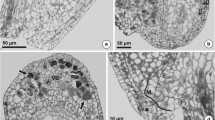Abstract
The processes of megasporogenesis and early megagametogenesis were cytologically investigated in Cupressus sempervirens L. in order to elucidate, at the cellular level, the origin of the megagametophyte. After pollination, sporogenous tissue developed in the chalazal region of the nucellus, but only one megaspore mother cell differentiated and divided meiotically without cell-wall formation. This led to the development of a cell with four nuclei which directly functioned as a megaspore. The C. sempervirens megagametophyte is thus tetrasporic, in contrast to the majority of conifers where the megagametophyte is monosporic. The consequenses of this observation are discussed from a genetics point of view.
Similar content being viewed by others
Author information
Authors and Affiliations
Additional information
Received: 15 August 1997 / Accepted: 19 September 1997
Rights and permissions
About this article
Cite this article
El Maâtaoui, M., Pichot, C., Alzubi, H. et al. Cytological basis for a tetraspory in Cupressus sempervirens L. megagametogenesis and its implications in genetic studies. Theor Appl Genet 96, 776–779 (1998). https://doi.org/10.1007/s001220050801
Issue Date:
DOI: https://doi.org/10.1007/s001220050801




